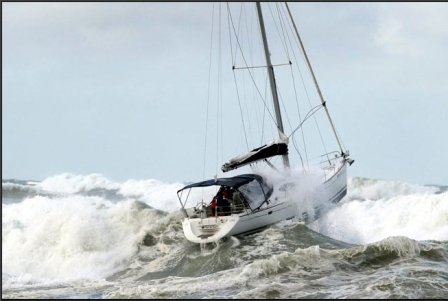Newbies, as well as veterans, fear storms and take it to be the greatest danger that they can face on the water – it isn’t always going to be ‘Plain Sailing’. Strong winds accompanied by high waves can fender bender a sailboat. If any sailor is caught in a thunderstorm, he has to know how he can stay safe in the arduous weather conditions.
Tactics to Sail in Storm
Most often, you will hear people say that boats are enduring that people. This simply means you will have to protect yourself first during an urgent situation. Make sure you have the adequate safety gear like tether or harness on the boat. The motion of the boat is going to be harsher during the storm. Thus, if you take early action, it will help in preventing sickness and injury as this can further lay your safety online. Make sure that you have some strategy to keep the boat under control.
Avoid Shallows
As the heavy weather sets in, the first thing that people do is drop the sales, start the motor, and sail towards the land. If you are able to reach the harbor safely and return to the dock, it is the safest option you have. Keep in mind that the heavy wind can turn narrow channels and shallow areas more dangerous. In fact, these can be hazardous in comparison to open water. Waves are steeper during a storm and can break the shallow areas. Hence, it becomes difficult to control the boat.
You have to take into account unforeseen circumstances such as engine dying or wind blowing out towards the rocks or some other obstructions. In case the direction of the wind is towards the shore, it might be risky to anchor. This is simply because when you anchor, the boat might go around. It is better to stay on open water and ride out using the tactics we have discussed below.
Reefing
Just when the wind starts being hard or you anticipate it will, you have to reef the sails. Obviously, you do not want loads of sail up as the strong wind hits as it will lead to capsizing. Also, it is better to furl the job or just reef the mainsail when the wind is manageable. Leaving the cockpit to drop the jib or to reef the main when the vessel is being tossed by the heavy wind can be quite dangerous.
It is necessary to pay attention to the reef early on. For this, you will have to monitor the wind. Either you should learn how to read the wind or simply use a good wind meter.
Storm Sails
Many offshore voyagers use special sails to use in heavy winds. The fabrics of standard sails are usually extremely light for high winds. If you have storm jib, it will enable you to sail in stronger winds, generally on a course which can reduce the effect of the wave.
Use a Sea Anchor
You should also invest in a sea anchor as it is just like a parachute in water. It will keep the bow pointed to the waves and the wind. However, it might take some time to learn.








